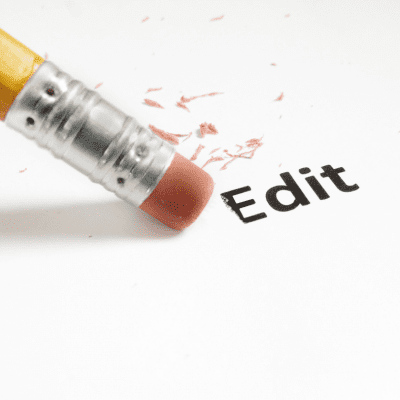Writers often experience a sense of euphoria when their manuscript is finally published. The endless revisions and editing of your book are over, any last adjustments to the storyline are complete, characters all play their assigned roles seamlessly and are put to bed, and all the toil and stress are over … right?
Well, not quite. Even traditionally printed bestsellers go through numerous revisions and drafts, after publication, and are reprinted. And if you’ve self-published, well, it’s pretty easy to make changes and upload your work again to the e-platform you use, or even get your vanity publisher to produce another edition of your work.
Can it be done? How to choose when to edit (or not) once it’s been published?
As pointed out above, yes, it can be done. The question might be more should it be done? Should you edit your book again? Well, once you’ve written and published your manuscript, you can definitely take a much-earned rest. This may not be a rest from writing altogether, but at least from this story.
Many writers take a break from their stories, usually in the editing process itself as well. Stephen King usually sticks his manuscript in a drawer for six weeks, apparently. But if you work on a computer, the same rule applies. Close the file for at least a week, or a month, and then come back to it with fresh eyes. Often problems or issues stick out more clearly after a break, fresh ideas come, and you often feel more ready to tackle it again.
In the break from working on this manuscript, you may also have received feedback from your online or traditional publishing platform in the form of readers that may be critical of something in your story, or suggest ways it can be improved. A lot of writers come to First Editing once they receive repeat suggestions to edit their work on some of these digital platforms. Many rue the fact they hadn’t reached out for a professional edit before.
However, editing itself may not mean the story is finished or the best it can be. You may find a better idea presents itself to you after some months, or that even the best editor in the world has missed one or two issues in your work. Or maybe you asked for a line edit, when it really needed far more attention. So, should it be done? If you have the time, the budget, and the desire to continue to improve your story, then yes, it can and should be done.
Steps
If you decide to go ahead with re-editing your manuscript, it’s important to understand what you’re trying to achieve. As outlined here in another of our blogs, editing is a multi-stage progress, and what you want to achieve may depend on the type of editing you think it needs, the areas you have identified as needing improvement, or simply what others have told you it needs.
Identify what needs fixing
If you’ve received a lot of feedback on your e-platform, writers may have helped identify that you switch POV, tenses are inconsistent, the formatting is all over the place, the story lacks the correct pace, it may contain too much detail or not enough, or more. This feedback can be very useful, particularly if it’s cemented by more than one reader. It may also confirm the feelings you had yourself. Or perhaps an inspiration came to you in the shower, or driving, or in the park about a way you could improve your story.
However, if you’re not too sure what needs work, then consider some elements we outline in this blog about the objectives of book editing. Consider the flow of your work (is it believable, seamless, realistic), the organisation (chapters, length, story arcs), your characters (likeable and relatable), dialogue (too much, not enough, incorrect style), plot (unique, worth reading), pacing (is it active when suspense is needed and slower when you use description), and POV (who tells the story and does it work). That is a lot of things to consider, but all influence the flow and presentation of your story.
Make the corrections
Once you’ve identified what needs work, it’s time to get to work. If there are style elements to correct (formatting of paragraphs, dialogue, numbers, capital letters), then you basically need to work on the entire document from beginning to end. You may wish to use a professional style guide to direct your work and keep it consistent.
If there are sections or characters that need work, then you can be more directed in your approach to those areas by working on story or character arcs, the goals and motivations of the characters, and how they achieve those.
Perhaps you’ve determined that some or all scenes are often missing scene setting elements like the use of objects, what the weather is like, what characters are wearing or feeling, etc, and you determine to focus on those elements.
Study the story elements for more help about what areas you may need to work on.
Proofread one last time
When you feel you’ve made all the changes you can, put the manuscript down again, and back in the drawer like Stephen King. Then pull it out again and proofread it one last time. When you’re done, run a spell check on it, and use any automated editing services you have access to. They will often find some basic errors you may have missed.
Reapprove your book
Once you’ve finished the editing process, it’s time to republish, approve your work, and get back to the business of promoting it as widely as you can. Tell your reviewers you’ve reworked it and let potential readers know where to buy a copy.
Editing Tips
Other than the usual checks for punctuation, grammar, formatting, style and the myriad of other things that could be part of the editing process that we have outlined in our blogs and webinars, here are two further, excellent pieces of advice:
Don’t over edit
Some writers can over do the self-editing process and become too picky or finicky in their approach. If this is you, perhaps set aside only so many hours a day so you don’t overdo it, and remain concentrated on the areas you have identified that need improvement.
Get beta readers or professional help
When you have taken the manuscript as far as you can, consider getting a beta reader(s) or employing an editor to assist you with further improvements. A beta reader or professional editor is more distant from your work and can see it and its problems more clearly. For professional editors, assessing and improving manuscripts is their bread and butter. First Editing has helped over 50,000 writers navigate their way through this process and we have an array of services to help you improve your work.
Conclusion
Editing is a multi-stage process whether you are still yet to be published for the first time, or reviewing your published work. How much time you spend on it can be determined by many factors, but writers who invest in this process with both time and money normally come out with a much better product. We always recommend those seeking input and help to get in contact with a professional editing service like First Editing.
















